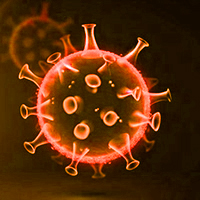Laboratory and demographic findings among patients with coronavirus disease 2019: a review

Accepted: March 15, 2021
Supplementary Table: 0
All claims expressed in this article are solely those of the authors and do not necessarily represent those of their affiliated organizations, or those of the publisher, the editors and the reviewers. Any product that may be evaluated in this article or claim that may be made by its manufacturer is not guaranteed or endorsed by the publisher.
Authors
Coronavirus disease 2019 (COVID-19) is the third known animal coronavirus, after severe acute respiratory syndrome (SARS) and Middle East respiratory syndrome coronavirus (MERS-CoV). The mean age of the infected patients was estimated to be between 50 and 69 years old. Accordingly, the COVID-19 mortality rate was calculated as 15%. In this regard, the essential component of prevention and planning is knowledge of laboratory and demographic findings among COVID-19 patients; therefore, the present study was conducted to investigate laboratory and demographic findings among these patients worldwide. This systematic review was performed on the articles published in English between January 1, 2019 and May 4, 2020, using MeSH-compliant keywords such as "COVID-19", "Laboratory, coronavirus disease-19 testing", and " demography " in international databases (PubMed, and web of science Scopus). Thereafter, the articles relevant to laboratory and demographic findings among COVID-19 patients were included in the final review. Reviewing the included articles showed changes in the mean lymphocytes count ranged from 0.7 to 39 in hospital or severe cases. Moreover, Leukopenia was not observed in patients with thrombocytopenia. In addition, C-reactive protein (CRP), leukocytes, D-dimer, FDP, FIB, neutrophils, AST, serum creatinine, t-troponin, troponin I, and blood bilirubin levels showed increasing trends in most studies conducted on COVID-19 patients. Notably, the elevated LDH level was more common among children than adults. According to the results of the present study, and by considering the clinical characteristics of COVID-19 patients on the one hand, and considering the changes in laboratory samples such as lymphocytes and other blood markers due to the damaged myocardial, hepatic, and renal tissues on the other hand, it is recommended to confirm the diagnosis of this infection by evaluating the patients’ blood samples using other diagnostic methods like lung scan.
How to Cite

This work is licensed under a Creative Commons Attribution-NonCommercial 4.0 International License.
PAGEPress has chosen to apply the Creative Commons Attribution NonCommercial 4.0 International License (CC BY-NC 4.0) to all manuscripts to be published.
Similar Articles
- Ankit Bansal, Prattay Guha Sarkar, Mohit D. Gupta, M.P. Girish, Shekhar Kunal, Vishal Batra , Jamal Yusuf , S. Safal, Saibal Mukhopadhyay , Sanjay Tyagi , Prevalence and patterns of coronary artery anomalies in 28,800 adult patients undergoing angiography in a large tertiary care centre in India , Monaldi Archives for Chest Disease: Vol. 92 No. 3 (2022)
- Christian Basile, Costantino Mancusi, Paola Gargiulo, Pasquale Perrone Filardi, Cinzia Perrino, Grazia Canciello, Maria Angela Losi, Giovanni Esposito, Aortic thrombosis: the forgotten source of ischemic stroke. A case report and systematic review of the literature , Monaldi Archives for Chest Disease: Vol. 92 No. 3 (2022)
- Anu Anna George, Kevin John John, Anil Jha, Ajay Kumar Mishra, Infections precipitating Takotsubo cardiomyopathy, an uncommon complication of a common infection , Monaldi Archives for Chest Disease: Vol. 93 No. 3 (2023)
You may also start an advanced similarity search for this article.

 https://doi.org/10.4081/monaldi.2021.1694
https://doi.org/10.4081/monaldi.2021.1694




